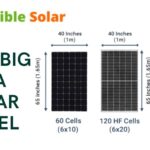How to Maximize Solar Panel Efficiency With a Multimeter: Easy Tips
Maximize Solar Panel Efficiency With a multimeter, set the meter to measure voltage and connect the panel’s positive and negative terminals to the corresponding meter leads. Testing a solar panel’s functionality with a multimeter helps ensure its proper operation and efficiency, enabling you to identify any issues that may impact its performance.
Solar panels are vital components of solar energy systems, and regular testing is crucial to maintaining their effectiveness. By following simple steps using a multimeter, you can quickly determine the health of your solar panel and take the necessary actions to optimize its output.
Understanding how to test your solar panel with a multimeter will empower you to maximize the benefits of solar energy in your home or business.

Credit: Bob Vila
Choosing The Right Multimeter
When it comes to testing a solar panel with a multimeter, selecting the right multimeter is crucial for accurate measurements. Here’s how to choose the right one:
Digital Or Analog
Choose a digital multimeter for precise readings and ease of use compared to analog models.
Ac/dc Measurement
A multimeter should be capable of measuring AC and DC voltage and current accurately for testing solar panels.
Understanding Solar Panel Voltage And Current
When testing a solar panel with a multimeter, it’s important to understand the voltage and current. Use the multimeter to measure the voltage output of the solar panel in direct sunlight. Then, measure the current by connecting the multimeter in series with the solar panel.
These readings will help assess the solar panel’s performance.
Voltage Output
Testing the voltage output of a solar panel is crucial.
It helps in assessing the power the panel can generate.
Current Output
Determining the current output of a solar panel is equally essential.
It indicates how much electricity the panel can produce.
Measuring Solar Panel Efficiency
Solar panel efficiency is a critical factor to consider when evaluating the performance of a solar panel. Measuring the open circuit voltage and short-circuit current provides valuable insights into the efficiency of a solar panel. Using a multimeter, these measurements can be easily obtained to assess the effectiveness of the panel in converting sunlight into electricity.
Open-circuit voltage
The open circuit voltage (Voc) of a solar panel refers to the maximum voltage it can produce when there is no load connected. It represents the potential for power generation under ideal conditions. To measure the open circuit voltage, follow these steps:
- Set the multimeter to the DC voltage setting.
- Connect the positive (red) probe to the positive terminal of the solar panel and the negative (black) probe to the negative terminal.
Read the voltage displayed on the multimeter. This value represents the open circuit voltage of the solar panel.
Short-circuit current
The short circuit current (Isc) of a solar panel is the maximum current it can deliver when the terminals are shorted. It indicates the panel’s capacity to supply current under optimal conditions. To measure the short-circuit current, follow these steps:
- Set the multimeter to the DC setting.
- Connect the multimeter in series with the solar panel by placing the positive (red) probe on the positive terminal of the panel and the negative (black) probe on the negative terminal.
- Read the current displayed on the multimeter. This value represents the short-circuit current of the solar panel.
Identifying And Troubleshooting Efficiency Issues
Efficiency issues can arise with solar panels, affecting their performance and output. It’s crucial to identify and troubleshoot these problems to ensure maximum efficiency. By using a multimeter, you can easily test your solar panel and address any potential issues. Here are some common efficiency issues and how to troubleshoot them:
Potential Voltage Drops
Sometimes, solar panels may experience voltage drops, which can significantly impact their efficiency. To test for potential voltage drops, follow these steps:
- Set your multimeter to the voltage measurement mode.
- Connect the multimeter’s positive lead (red) to the solar panel’s positive terminal.
- Connect the multimeter’s negative lead (black) to the solar panel’s negative terminal.
- Measure and note the voltage reading displayed on the multimeter.
- If the measured voltage is significantly lower than the panel’s expected voltage rating, there might be a voltage drop issue.
Corrosion And Dirt
Corrosion and dirt accumulation on How to Maximize Solar Panel Efficiency with a Multimeter can impact their efficiency by obstructing sunlight. To test for corrosion and dirt issues, follow these steps:
- Set your multimeter to the resistance measurement mode.
- Disconnect the solar panel from any power sources.
- Connect the multimeter’s positive lead (red) to one of the solar panel’s contact points.
- Connect the multimeter’s negative lead (black) to the other contact point.
- Observe the resistance reading displayed on the multimeter. If the reading is abnormally high, there might be corrosion or dirt build-up affecting the connection.
Once you’ve identified potential efficiency issues with your solar panel using a multimeter, it’s essential to address them promptly. Whether it’s investigating voltage drops or cleaning panels to remove dirt or corrosion, taking action can help restore the panel’s efficiency and maximize its energy production.
Optimizing Solar Panel Performance
Ensuring the optimal performance of your solar panel is crucial to maximizing energy production and efficiency. By testing your solar panel with a multimeter, you can gather valuable information about its performance and identify any issues that might be affecting its output. Two key factors that significantly impact solar panel performance are the tilting and cleanliness of the panels, as well as shade analysis. Let’s dive deeper into each of these factors.
Tilting And Cleaning Panels
Maintaining the correct tilt angle of your solar panel is essential to maximizing its exposure to sunlight throughout the day. By adjusting the tilt angle, you can optimize the panel’s efficiency and maximize energy production. Consider the latitude of your location when determining the ideal tilt angle, as this will vary depending on your geographical position.
Cleaning your solar panels regularly is also critical to ensuring optimal performance. Dust, dirt, bird droppings, and other debris can accumulate on the surface of the panels, reducing their efficiency and blocking sunlight absorption. It is recommended to clean the panels with a soft cloth or sponge and mild detergent. Avoid using abrasive materials or harsh chemicals that could damage the surface.

Credit: www.amazon.com
Frequently Asked Questions For How to Maximize Solar Panel Efficiency with a Multimeter
How Do I Test a Solar Panel With a Multimeter?
To test a solar panel with a multimeter, set the meter to DC voltage mode and place the positive probe on the positive terminal of the panel and the negative probe on the negative terminal. The reading should indicate the voltage output of the panel.
What Should Be The Reading On A Multimeter When Testing A Solar Panel?
When testing a solar panel with a multimeter, the reading should indicate the voltage output of the panel. The exact reading will depend on factors such as the type and size of the panel, as well as the amount of sunlight it is receiving.
Can a multimeter be used to test the efficiency of a solar panel?
While a multimeter can provide information about the voltage output of a solar panel, it cannot directly measure the efficiency of the panel. To determine the efficiency, you would need to compare the actual power output of the panel to its maximum theoretical power output.
Conclusion
How to Maximize Solar Panel Efficiency with a Multimeter is an essential step in ensuring its proper functioning. By following the simple steps outlined in this guide, you can accurately measure the panel’s voltage and current output. Regular testing can identify any issues early on and help maintain optimal performance.
Keep assessing your panel for sustainable energy production.




